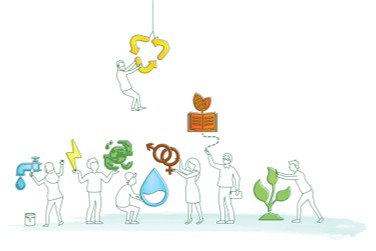Executive Summary
A subordinated loan (subordinated or junior debt) is a form of debt capital that the enterprise pays back to the creditor. What makes subordinated loans special is that the creditors are set up to take higher risk as compared to other loan providers. In case you go bankrupt, they will only receive their payments once senior creditors have been fully paid back. This is why subordinated loans are considered ‘first loss capital’ in the sense that the creditor providing this type of loan is the first creditor who will lose his or her money if your business does not succeed. Thus, subordinated loans make it less risky for other creditors such as banks, financial institutions or other companies to lend you money. Subordinated loans are, however, paid back before preferred and common shareholders, which means that equity investors will consider the subordinated loan in their risk assessment and investment decision just like any other loan. (ROOTS OF IMPACT, 2020)
When are subordinated loans a suitable investment option?
Subordinated loans are interesting if you can use them to reduce the risk for other lenders and hence mobilise additional debt capital with better financial terms and conditions. Moreover, you may find yourself needing to invest into scaling your water-related enterprise, but not having the necessary collateral (e.g., assets or private capital) to raise traditional debt like regular bank loans. Subordinated loans can provide an additional funding option that does not necessarily require collateral as they can either be secured or unsecured. To cater to this additional risk, private creditors usually charge higher interest rates. However, many development finance institutions are involved in schemes that, among others, provide subordinated loans at more generous conditions.
The following (non-comprehensive) characteristics and implications provide you with an overview to analyse the pros and cons for this investment instruments:
| Enterprise Lifecycle | Enterprises across all stages that are able to service debt |
| Amount | Depending on enterprise needs |
| Pay-back period (Maturity) | Based on the funding need of an impact enterprise, potentially flexible repayment schedules |
| Use of funds | Mostly unrestricted |
Source: Based on (Roots of Impact, 2020)
The following table summarises some key characteristics of subordinated loans and implications you should consider:
| Characteristics | What does this mean for your enterprise |
| A sub-ordinated loan is a form of debt capital. | Your enterprise needs enough cash flow to service debt. The financial pressure to pay back the loan may lead to decisions that prioritise revenues over your envisaged impact (mission drift). |
| It provides debt capital that takes junior positions. | It provides an additional layer of security to other debt capital providers that take a senior position, allowing your enterprise to unlock further debt to scale. |
| It adds a long-term liability with second payment priority after senior debt. | In case you plan to raise equity investments at a later stage, you will have to use the subordinated loan in a way that outweighs the additional risk for future equity investors. |
| No equity is acquired and there is no board representation. | You can continue to manage your enterprise without having to engage and manage a(nother) shareholder. |
Key features
(ROOTS OF IMPACT, 2020) have established a number of features and considerations related to subordinated loans that are important to understand:
-
Priority: Priority of liquidation indicates which investor or creditor is first in line to receive payments in case of bankruptcy of the enterprise. A subordinated loan is considered lower in priority than a senior loan, and thus will be paid after all the other senior creditors have been paid out in full. On the other hand, the subordinated lender will receive payments prior to the shareholders. Should the company have insufficient capital to pay off the subordinated loan, a pro rate percentage of the remaining assets or proceeds should be distributed.
-
Catalytic effect: The goal of the subordinated loan is to attract investors who would otherwise not have provided capital and to mobilise volume of capital that would not have been obtained. This defines its catalytic nature and is also called financial additionality.
Tips to build your investment case as a young water-related enterprise
Basic requirements
As with regular loans, a subordinated loan is usually best suited for an enterprise that has a proven business model and is able to service debt. Due to the higher risk, the lender usually expects higher interest payments as a compensation. Thus, your enterprise will need to clearly demonstrate that it is in a strong financial position and generates high cash flow which can cover the liabilities. Another factor that is important if you are applying for a secured subordinated loan (loan protected by a piece of collateral such as business equipment) is that your company should own assets that would serve as collateral for the lender. In these cases, the investor will pay close attention to your debt obligations towards other lenders, since in the event of bankruptcy, liquidated assets would first be paid to the senior lenders.
Leveraging your impact profile to access subordinated loans
Setting up de-risking structures to enable enterprises to leverage capital is a common financing mechanism to foster economic activity and growth. Beyond this, actors with an interest in specific development impacts are among the finance providers for subordinated loans. You should therefore explore this option if…
…providers of subordinated loans exist that have a specific focus on your market
One of several relevant facilities is, e.g., the Watercredit Investment Fund 3 (WCIF3). This is a blended fund that provides debt financing to financial institutions and enterprises serving the water and sanitation needs of families living in poverty in Asia. It was the first fund launched by WaterEquity, an impact investment manager established by water.org, that leverages a first-loss guarantee to mobilise capital from impact investors. The fund is covered by a first-loss guarantee on all shareholder capital as well as the loan facilities for up to $5 million provided by WaterEquity in case of default. In case of losses, the guarantee will first be used in repayment of the senior loan facility (here Bank of America); second, in the repayment of unsecured indebtedness owed by the fund; third, by the different classes of equity according to payment priority. (CONVERGENCE, 2019)
The Green Climate Fund (GCF) is another institution providing sub-ordinated loans through national entities. The receiving entities must be accredited and have to develop specific investment concepts and strategies in line with the GCF’s investment strategy, framework and criteria, policies, environmental and social standards, gender policy, and other requirements, which have a strong impact focus (see https://www.greenclimate.fund). Financing recipients (e.g., NGOs, start-ups, SMEs, cooperatives) must apply to accredited entities (or executing entities) for funding. Amongst other financing instruments, these entities offer subordinated loans that are tailored to make climate change mitigation and adaptation projects viable by covering full or incremental costs of investments. While GCF is focusing on project finance, subordinated loans are also provided for private sector projects and conditions are negotiated to ensure that maturity, grace and interests are tailored to the needs of the climate project and program funded by the Fund. (GCF, 2014)
Looking at the investment criteria for a specific fund will help you determine whether you qualify for a subordinate loan. In the case of WaterEquity’s WCIF3, the fund will only consider “financial institutions and enterprises that expand access to safe water and sanitation products, services, or financing for families living in poverty […] targeting countries in Asia”. It does not invest more than 30% as subordinate loans and although the fund provides mostly senior debt, it considers subordinate debt for financial institutions that have a gross loan portfolio that’s above $50 million. Potential investees have to submit a loan application where WaterEquity will be assessing the following (CONVERGENCE, 2019):
-
Risk factors and investment rationale
-
Operational and financial performance (i.e., growth, profitability, and efficiency)
-
Management and governance
-
Capital structure and lender base
-
Strategy and competitive position
-
Credit score based on a proprietary scorecard
-
Development impact, including with standards selected from IRIS+
-
Country risk score, which is focused around four primary risk areas: political risk, economic risk, financial system, and business environment
-
ESG score, based on a proprietary scorecard
…you are aligned with other objectives behind the setting up of subordinated loans as de-risking structures that you use to build your case
In some cases, financers of subordinated loans pursue political objectives to support growth of MSMEs, to contribute to employment creation or to foster a more inclusive economy. Explore if and how you can highlight your (potential) contributions to such objectives.
… you can negotiate better conditions for subordinated loans
Some debt providers link financial rewards to the achievement of impact, for example by reducing the interest rate. You should therefore explore if you can negotiate rewards (e.g., reduced interest rates) for reaching a certain impact, e.g., related to SDG 6 targets (water and sanitation), SDG 2 (zero hunger) or similar. A precondition for this is that you have a well-established impact model and management system. Should the business reach a certain amount of impact, the company’s interest rate can be reduced as a reward (ROOTS OF IMPACT, 2020).


